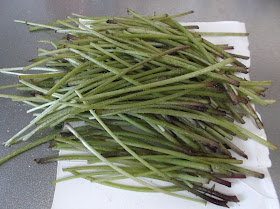今日は父から夏みかんを1箱もらいました。これで本当に最後だそうです。箱の中にはフキが1袋入っていたので、父に電話して、下ごしらえの仕方を教わりました。小さいので、皮をむく必要はないと言ってくれました。皮をむくのがフキの下ごしらえで一番退屈なことなので、それを聞いて安心しました。
A common way is to first place fuki on a cooking board, sprinkle some salt, and roll them. This technique is called ita zuri.
一般的な方法では、まずフキをまな板に載せ、塩を振りかけて、転がします。板ずりといいます。
Put plenty of water in a large pot, and bring to a boil. Add fuki, and parboil for 3-5 minutes depending on the thickness.
大きな鍋に水をたっぷり入れ、沸騰させ、フキを加え、太さに応じて3~5分茹でます。
Cool in cold water, and drain.
冷水で冷やし、水を切ります。
Then, you have to peel the skin from each fuki. This is the most tediuous part, as I said above.
次に、フキそれぞれから皮をむきます。上記のとおり、一番退屈な部分です。
Of course, I omitted this step. I made kinpira with just a small portion of fuki.
もちろん、私はここは省きました。フキをちょっとだけ使ってきんぴらを作りました。
Like I mentioned several times in my blog, fuki should not be confused with fukinoto. Wikipedia does not clearly distinguish fuki (leaf stalk of fuki) from fukinoto.
The book, Japanese Cooking: A Simple Art, explains fuki as follows:
このブログで何度も言っているように、フキをフキノトウ(蕗の薹、ふきのとう)と混同しないでください。Wikipediaでもフキ(フキの葉柄(ようへい)とフキノトウをはっきり区別していません。
Japanese Cooking: A Simple Artという本ではフキを次のように説明しています。
But no mention of fukinoto.フキノトウについて言及はないです。
Previous post on kyarabuki
Previous post on fukinoto
きゃらぶきに関する過去の記事
フキノトウに関する過去の記事






Leaf stalk (fuki) and flower bud (fukinoto) are from the same plant: Petasites japonicus?
ReplyDeleteTomorrow I will get 3 Petasites japonicus plants together with 2 Myoga plants. I also ordered seeds for edible chrysnthemum, mizuna and two different types of perilla.
Kiki: Yes, exactly. The same plant. The flour stalk comes out first toward the end of winter (late March around here), followed by the leaf stalk.
ReplyDeleteWow! Quite impressive! All those plants at the same time? They will surely keep you busy!
Oh! My favourite cookery book!
ReplyDeleteNow that I look once more at the drawing, I am wondering if I don't see this plant sometimes in my Vietnamese shop... I must check because I still don't know at least half of the plants they have.
Kiki, I am looking forward to hear about your gardening adventures. You are both so lucky to have a garden.
I also have planted edible chrysanthemum this year, mizuna and shiso and mitsuba...
Kiki: Yes, your favorite Tsuji's book.
ReplyDeleteI have no idea if the plant you see is fuki. Do a Google image search for 蕗, and you will see lots of images. Some fuki varieties are incredibly huge!
http://hojinashi.cocolog-nifty.com/photos/uncategorized/101.jpg
Forgot to mention: coltsfoot (named in the book) is a totally different plant. Same family (Asteraceae) but different: the botanic name is Tussilago farfara! I have coltsfoot in my garden, it just moved in on it's own. It has nice bright yellow blossoms but I would not eat it.
ReplyDeleteConcerning Pestasites. The biggest I have ever seen were on a hiking tour down in the Wutach creek, Black forest, Germany - some reached over my hip. http://commons.wikimedia.org/wiki/File:Wutach_fg3.jpg
First of all, my preceding comment was meant for Sissi, not Kiki. Sorry for my sputidity!
ReplyDeleteKiki: Yes, yes, I knew it. Fuki is fuki.
Thanks for the link. They are big!
Hiroyuki, don't worry, I have understood it was meant for me :-) Thank you for the link.
ReplyDelete